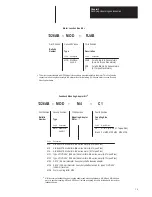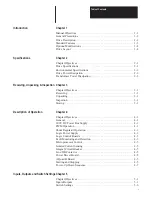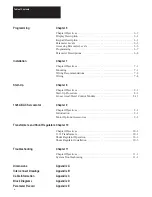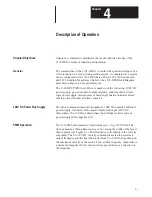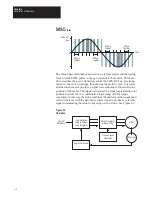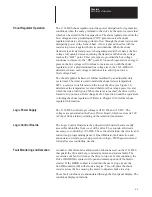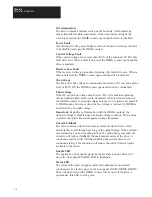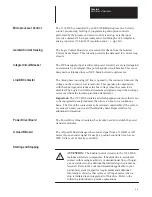
Chapter 4
Description of Operation
4-3
Shunt Regulator Operation
The 1391-DES shunt regulator provides power dissipation for regenerative
conditions when the energy returned to the drive by the motor exceeds that
which can be stored in the bus capacitors. The shunt regulator monitors the
bus voltage and at a predetermined “ON” point activates the shunt
regulator transistor, allowing current to flow through the shunt resistor and
dissipating power in the form of heat. A fuse is placed in series with the
resistor to protect it against short circuit conditions. When the shunt
transistor is activated and power is being dissipated at the resistor, the bus
voltage will quickly decrease, turning the transistor off when the voltage
reaches the “OFF” point. This cycle repeats, provided the bus voltage
continues to increase to the “ON” point. If too much regenerative energy is
present, the bus voltage will continue to increase even with the shunt
regulator on. At a predetermined bus voltage level, the 1391-DES will
determine that an overvoltage condition exists, and trip out on an
Overvoltage Fault.
The shunt regulator behavior is further modified by an adjustable duty
cycle timer. The timer is used to model the shunt resistor temperature.
SW1, a selector switch located on the top of the drive (see Figure 1.1)
determines the temperature level and therefore the average power level at
which the drive will trip out. When this level is reached, the drive will be
forced to trip out on an Overvoltage Fault. This action would be equivalent
to turning the shunt regulator off. Refer to Chapter 10 for further shunt
regulator information.
Logic Power Supply
The 1391-DES control logic voltage is
±
12V DC and +5V DC. The
voltages are generated on the Power Driver Board, which receives its 36V
AC input from a tertiary winding on the isolation transformer.
Logic Control Boards
The Logic Control Boards are the printed circuit boards that are readily
accessible behind the front cover of the drive. They contain all circuits
necessary to control the 1391-DES. These circuits include: the velocity and
current loop, programming panel, A Quad B Board, fault detection and
annunciation circuits, power-up/power-down logic, PWM generation and
forward/reverse controlling circuits.
Fault Monitoring and Detection
A number of fault monitor and detection functions exist on the 1391-DES
that guard the drive and help to minimize motor and system faults. The
occurrence of a fault will cause the drive to trip out. In this condition, the
Drive OK (DROK) contact will open and remain open until the fault is
cleared. If the DROK contact is wired into the user’s stop circuit, the
line/DB contactor (M) will also de-energize. This will place the shunt
resistor across the bus causing the motor to dynamic brake to a stop.
These fault conditions are annunciated through the front panel display. The
conditions displayed include:
Summary of Contents for 1391-DES Series
Page 2: ...User Manual 1391 DES Digital AC Servo Drive ...
Page 10: ...Chapter 1 Introduction 1 10 End of Chapter ...
Page 38: ...Chapter 5 Inputs Outputs and Switch Settings 5 8 End of Chapter ...
Page 85: ...Chapter 8 Start Up 8 16 End of Chapter ...
Page 89: ...Chapter 9 1326 AC Servomotors 9 4 End of Chapter ...
Page 107: ...Chapter 11 Troubleshooting 11 12 End of Chapter ...
Page 123: ...Appendix B Interconnect Drawings B 12 End of Appendix ...
Page 127: ...Appendix C Cable Information C 4 End of Appendix ...
Page 135: ...Appendix E Parameter Record E 8 End of Appendix ...
Page 136: ...Notes ...
Page 137: ...Notes ...
Page 138: ...Notes ...
Page 139: ...Notes ...
Page 140: ...Notes ...
Page 141: ...Notes ...
Page 142: ...Notes ...
Page 143: ...Notes ...
Page 144: ...Notes ...
Page 145: ...Notes ...
Page 148: ...IMC is a trademark of Allen Bradley Company Inc ...







